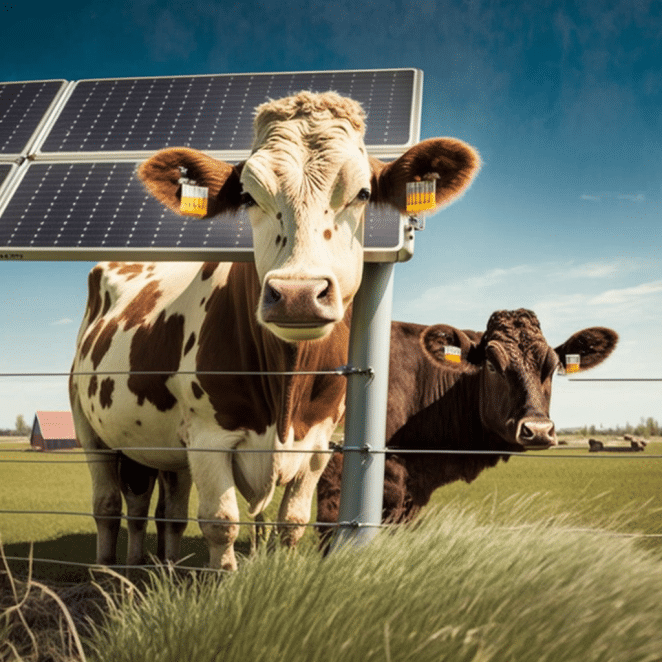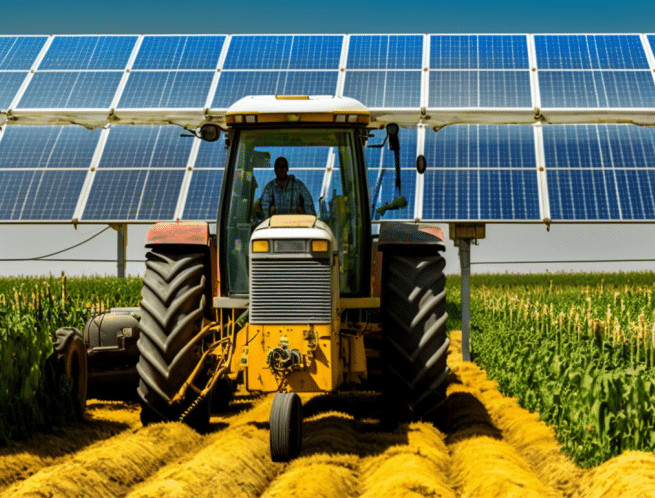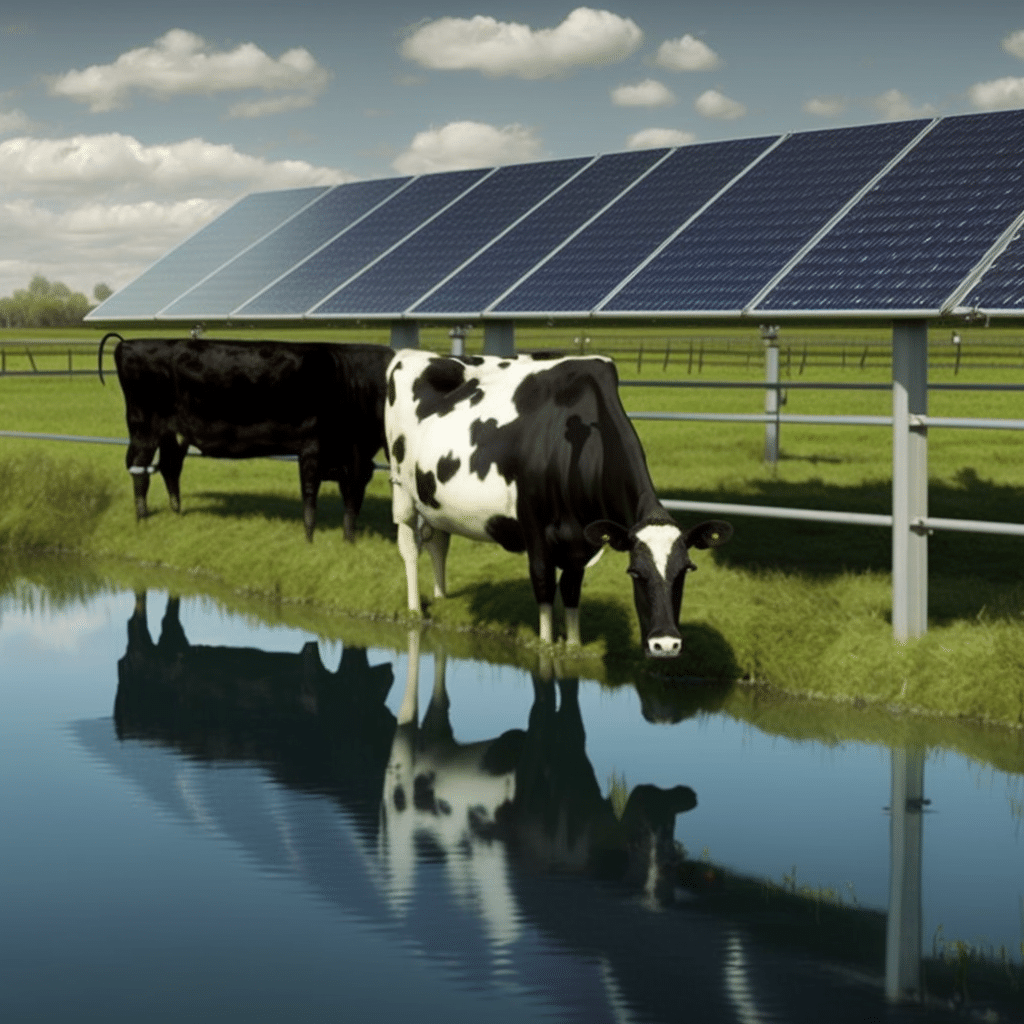In the quest for sustainable solutions to global challenges, agrivoltaics has emerged as a groundbreaking innovation. By combining agriculture and solar energy, this approach promises to optimize land use, increase farm productivity, and accelerate the adoption of renewable energy. In this comprehensive guide, we’ll explore the world of agrivoltaics, its benefits, and the potential impact on the future of farming and solar power.
The Concept of Agrivoltaics: A Win-Win Solution
Agrivoltaics, also known as agri PV or agri voltaic farming system, refers to the co-development of land for both solar power generation and agricultural production. This approach involves installing solar panels above crops, enabling farmers to harness solar energy while simultaneously cultivating their land.
Key advantages of agrivoltaics include:
- Optimized land use: With increasing pressure on land resources, agrivoltaics offers a way to utilize the same land for both energy generation and agriculture, maximizing its productivity.
- Increased crop yield: Studies have shown that solar panels can create a microclimate that enhances crop growth. By providing shade and reducing evaporation, they help maintain optimal growing conditions for certain crops.
- Boosted solar panel efficiency: The presence of crops can also benefit solar panels. By reducing the surrounding air temperature, they improve the panels’ efficiency and output.
Agrivoltaic Systems and Compatible Crops
Not all crops are suitable for agrivoltaic systems. Those that thrive in partial shade, have low height requirements, and require less water are the most compatible with this approach. Examples of suitable agrivoltaic crops include:
- Lettuce
- Spinach
- Tomatoes
- Beans
- Herbs
When designing an agrivoltaic system, it’s essential to select the right crops and configure the solar panel layout to ensure optimal growing conditions and energy production.
The Agrivoltaics Market: Companies and Costs
Numerous agrivoltaic companies have emerged in recent years, offering innovative solutions to farmers and energy producers. These companies specialize in designing and installing agri voltaic systems tailored to clients’ specific needs and regional conditions.
The cost of implementing an agrivoltaic system varies depending on factors such as the size of the project, the type of solar panels, and the complexity of the installation. However, the long-term benefits of reduced water usage, increased crop yields, and renewable energy generation often outweigh the initial investment.
To learn more about the costs and benefits of integrating solar energy with agriculture, check out our comprehensive guide on solar with battery price.
Agrivoltaics: A Sustainable Future for Agriculture and Solar Energy
Agrivoltaics has the potential to revolutionize the way we approach agriculture and solar energy. By harnessing the power of synergy, we can create a more sustainable and productive future for both industries.
As the agrivoltaics market continues to grow, we can expect to see increased adoption of this innovative approach worldwide. To stay informed about the latest developments in renewable energy and energy storage, explore our extensive resources, including our guide to cutting-edge battery technologies and our overview of hybrid solar inverters.
Agrivoltaics: A Solution to Land Scarcity and Climate Change
As the world’s population continues to grow, and the effects of climate change become increasingly apparent, the need for sustainable solutions to food production and energy generation is more pressing than ever. Agrivoltaics presents an opportunity to address both of these challenges simultaneously, offering a way to mitigate climate change while ensuring food security.
Tackling Land Scarcity
One of the most significant challenges facing agriculture today is the scarcity of available land. As urbanization and industrialization consume more land, the competition for space becomes fiercer. Agrivoltaics offers a solution to this issue by enabling the efficient use of land for multiple purposes. By integrating solar panels with agricultural production, the same land can be utilized for both energy generation and crop cultivation, reducing the need for additional land resources.
Combating Climate Change
Agrivoltaics can also play a vital role in the global fight against climate change. By promoting the adoption of renewable energy, this approach helps to reduce greenhouse gas emissions and reliance on fossil fuels. Additionally, the increased crop yields and reduced water usage associated with agrivoltaics contribute to a more sustainable, climate-resilient agricultural system.
The Future of Agrivoltaics
As awareness of the benefits of agrivoltaics grows, we can expect to see increased investment and research in this field. The development of new technologies, such as advanced solar panels and innovative agricultural practices, will further enhance the effectiveness and efficiency of agrivoltaic systems.
Governments and policymakers also have a crucial role to play in promoting the adoption of agrivoltaics. By providing incentives and support for farmers and energy producers to invest in these systems, they can help drive the growth of this market and facilitate the transition to a more sustainable and resilient energy and agricultural landscape.
Case Studies: Agrivoltaics in Action
Case Study 1: Fraunhofer Institute for Solar Energy Systems, Germany
In Germany, the Fraunhofer Institute for Solar Energy Systems conducted a pilot project that combined solar panels and arable land to test the feasibility of agrivoltaics. The project used 720 solar panels installed on a 0.3-hectare plot, with crops grown beneath the panels.
The results showed that the agrivoltaic system produced 1,200 kWh/kWp of solar energy, which was 30% more efficient than a conventional ground-mounted solar system. Additionally, the project demonstrated that the partial shading from the solar panels increased crop yield by up to 60%.
Case Study 2: AgriSolar, Oregon, USA
AgriSolar, a company based in Oregon, USA, has been working on agrivoltaic projects since 2016. They have developed an innovative solar racking system that allows for easy access to crops and machinery while minimizing shading effects. This system has been successfully implemented on several farms in the United States, with a focus on high-value crops such as wine grapes and berries.
The success of these projects has demonstrated the potential for agrivoltaics in the United States and has inspired further research and development in the field.
Frequently Asked Questions (FAQs)
Q: What is the main advantage of agrivoltaics?
A: The main advantage of agrivoltaics is the efficient use of land for both agriculture and solar energy production. This approach maximizes land productivity, allowing farmers to cultivate crops while generating renewable energy.
Q: Are there any specific crops suitable for agrivoltaics?
A: Crops that thrive in partial shade, have low height requirements, and require less water are suitable for agrivoltaics. Examples include lettuce, spinach, tomatoes, beans, and herbs.
Q: How does agrivoltaics impact crop yield?
A: Agrivoltaics can increase crop yield by providing shade and reducing evaporation, which helps maintain optimal growing conditions for certain crops. The presence of solar panels can also create a microclimate that enhances crop growth.
Q: What factors determine the cost of implementing an agrivoltaic system?
A: The cost of implementing an agrivoltaic system depends on factors such as the size of the project, the type of solar panels, and the complexity of the installation. However, the long-term benefits of reduced water usage, increased crop yields, and renewable energy generation often outweigh the initial investment.
Q: How does agrivoltaics contribute to combating climate change?
A: Agrivoltaics contributes to combating climate change by promoting the adoption of renewable energy, which helps to reduce greenhouse gas emissions and reliance on fossil fuels. Additionally, the increased crop yields and reduced water usage associated with agrivoltaics contribute to a more sustainable, climate-resilient agricultural system.
Q: How can I start implementing agrivoltaics on my farm?
A: To start implementing agrivoltaics on your farm, you should first research the potential benefits and drawbacks for your specific crops and location. You may also want to consult with agrivoltaics experts or companies that specialize in these systems. Once you have a better understanding of the feasibility and potential benefits, you can begin exploring options for solar panel installation and crop management.
Q: What are the maintenance requirements for agrivoltaic systems?
A: Maintenance requirements for agrivoltaic systems are generally similar to those of traditional solar installations. This includes regular cleaning of the solar panels, inspecting the mounting structures for damage or corrosion, and monitoring system performance. However, maintenance may also involve additional considerations related to crop management, such as adjusting panel height or spacing to optimize sunlight exposure for both the panels and the crops.
Q: Can agrivoltaics be used for animal farming as well?
A: Yes, agrivoltaics can also be integrated with animal farming systems. For example, solar panels can be installed over animal enclosures, such as poultry houses or cattle shelters, providing shade and reducing heat stress for the animals. This approach can also help to reduce water usage and improve overall farm efficiency.
Q: Is there government support or funding available for agrivoltaic projects?
A: Government support and funding for agrivoltaic projects may vary depending on your location. Some countries or regions offer incentives, grants, or tax credits for renewable energy projects or sustainable agriculture initiatives. It’s essential to research the specific programs and opportunities available in your area to determine the potential benefits and support for agrivoltaic projects.
Q: Are there any limitations or challenges to implementing agrivoltaics?
A: Some challenges and limitations to implementing agrivoltaics include the initial investment required for solar panel installation, potential shading effects on crops, and the complexity of managing both solar energy production and crop cultivation. However, ongoing research and development in agrivoltaic systems are helping to address these challenges and improve the overall efficiency and effectiveness of this approach.
- Leafy greens: Spinach, lettuce, kale, and Swiss chard are well-suited for agrivoltaic systems due to their shade tolerance and low height requirements.
- Herbs: Basil, parsley, cilantro, and mint can grow well in partially shaded conditions.
- Legumes: Beans, peas, and lentils can adapt to varying light conditions and have shallow root systems that do not interfere with solar panel installation.
- Root vegetables: Carrots, beets, and radishes can grow well in agrivoltaic systems as they do not require full sunlight throughout the day.
- Berries: Berry plants like raspberries, blackberries, and strawberries can thrive in partial shade and may even benefit from reduced heat stress.
- Specialty crops: Some high-value specialty crops, such as truffles and certain medicinal plants, can also be suitable for agrivoltaic systems due to their specific growing requirements.



